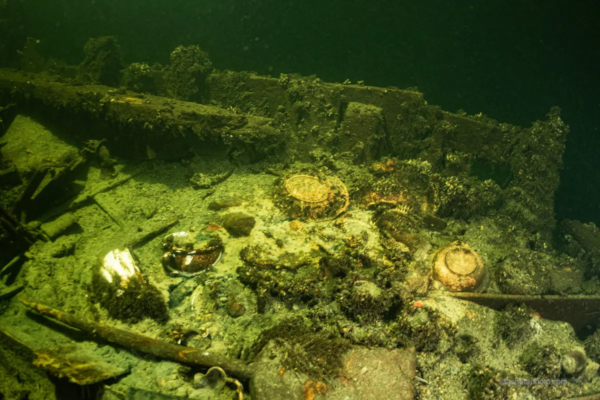Recently, a maritime exploration team from Poland discovered a 19th-century shipwreck in the southern waters of the Baltic Sea near Sweden, filled with crates of champagne, mineral water, and porcelain among other valuable cargo items, which are remarkably well-preserved to this day, prompting their excitement.
According to a press release from the Baltictech Team, a team of six ocean explorers sailed towards the southern part of the island of Öland in Sweden about 20 nautical miles (37 kilometers) away to explore a fishing boat that was rumored to have sunk in the area. After two lengthy deep dives, they achieved this expedition’s success.
The team reported that two divers meticulously observed the wreckage of the sunken ship and identified it as a small 19th-century sailboat. Despite the ravages of time, the ship’s hull remained intact, with only minor damage to the bow, and most of the cargo onboard was also well-preserved.
“The sides of the ship were packed with unopened crates of champagne, wine, mineral water, and porcelain,” said diver and leader of the Baltictech Team, Tomasz Stachura, in the press release. “The quantity of cargo was so vast it was difficult to estimate precisely, but visually there were over a hundred bottles of champagne in glass bottles and several baskets of mineral water in ceramic bottles.”
While finding champagne on shipwrecks in the Baltic Sea is not uncommon, the sheer quantity discovered in this case is highly unusual.
Stachura, who specializes in underwater shipwreck photography with 40 years of diving experience, noted that “discovering a ship laden with so many cargoes is a first for me.”
Although the vintage champagne from the 19th century is sure to pique people’s curiosity, the historically significant mineral water is undoubtedly intriguing.
“In that era, mineral water was considered a ‘rare’ commodity, almost as precious as medicine, usually only found on the dining tables of royal family members,” the team stated. “Given its rarity and value, it was often escorted by police or military during transportation. We found around 100 sealed bottles of Selters brand mineral water.”
Selters is a well-known German producer that still produces mineral water to this day, deriving its water source from the Taunus Mountains in the Selters region of Hesse, renowned for its high concentration of sodium hydrogen carbonate, earning it the moniker of “natural soda water.”
Through an investigation of the mineral water labels, the team determined that the production dates of this batch of mineral water ranged from 1850 to 1867. Based on this, the team deduced that the ship capsized sometime in the latter half of the 19th century.
Adding to the intrigue, not only does the producer of this mineral water still exist, but even the manufacturer of the ceramic bottles used for packaging the water remains in operation. Currently, the diving team is making contact with these businesses to uncover further details.
Furthermore, they plan to collaborate with the Dutch Marine Data Foundation MARIS, Södertörn University in Sweden, and Professor Johan Rönnby, who oversees all underwater research in Sweden, to conduct a more in-depth exploration of this rare find.

